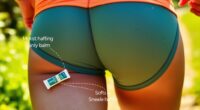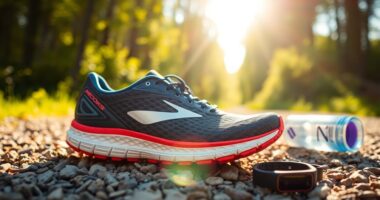To stay safe during sunny runs, wear a wide-brimmed hat or cap and UV-protective sunglasses to shield your face, neck, and eyes. Apply broad-spectrum sunscreen with SPF 30 or higher on all exposed skin, reapplying every two hours or more often if sweating. Plan your runs during cooler times or shade to minimize direct sun exposure. Incorporate hydration strategies and wear moisture-wicking clothing for comfort. Keep these tips in mind as you explore ways to protect yourself from harmful rays.
Key Takeaways
- Wear wide-brimmed hats and UV-protective sunglasses to shield your face, neck, and eyes during runs.
- Apply broad-spectrum SPF 30+ sunscreen to all exposed skin and reapply every two hours.
- Schedule runs during cooler times or seek shaded routes to minimize sun exposure.
- Use moisture-wicking, lightweight clothing that covers skin and helps keep your body cool.
- Hydrate regularly with water and electrolyte drinks to prevent dehydration and support sun safety.

Are you aware of how vital sun safety is when you’re out running? The sun’s rays can be powerful and damaging, especially during those long morning or afternoon runs. Protecting yourself isn’t just about feeling comfortable; it’s about safeguarding your skin and overall health. One of the most effective ways to do this is by wearing appropriate sun protection gear. Think lightweight, wide-brimmed hats or caps that shield your face and neck from direct sunlight. Sunglasses with UV protection are also essential—they prevent eye damage and reduce glare, helping you maintain clear vision. Applying a broad-spectrum sunscreen with at least SPF 30 is essential, especially on exposed skin. Make sure to cover all areas that aren’t covered by clothing, including your ears, neck, and the backs of your hands. Reapply every two hours, or more often if you’re sweating heavily or running in hot, humid conditions. It’s also important to understand that Gold IRA Rollovers can be part of a diversified retirement strategy, which emphasizes the importance of safeguarding your future assets against inflation and economic downturns.
Hydration tips go hand-in-hand with sun safety. When you’re out in the sun, your body loses water faster through sweat, which can lead to dehydration—an issue that hampers your performance and health. To stay properly hydrated, start drinking water before you head out, and continue sipping small amounts regularly throughout your run. Electrolyte drinks can be helpful, especially during long runs, because they replenish salts lost through sweat. Avoid waiting until you’re thirsty; thirst is a late indicator of dehydration. Instead, aim to hydrate consistently, about every 15 to 20 minutes, depending on the intensity and weather conditions. Carry a water bottle or use a hydration pack so you can access fluids easily. Wearing moisture-wicking clothing also helps keep sweat off your skin, reducing the risk of chafing and helping your body cool down more efficiently.
Strategic planning is key to sun safety. Try to schedule your runs during cooler parts of the day, like early morning or late evening, to avoid peak sun hours. When you do run during midday, take extra precautions. Seek shaded routes when possible, and always wear your sun protection gear. Keep an eye on the weather forecast to anticipate UV index levels—higher UV indexes mean more intense sun exposure, prompting you to be even more diligent with your sun protection measures. Remember, protecting yourself from sun damage isn’t just about preventing burns; it’s about long-term health, reducing your risk of skin cancer and premature aging. By combining proper sun protection gear, hydration tips, and thoughtful planning, you can enjoy your runs safely and comfortably, even when the sun’s at its strongest.
Frequently Asked Questions
How Often Should I Reapply Sunscreen During a Run?
You should reapply sunscreen every two hours during your run to maintain protection. Keep in mind sunscreen application intervals, especially if you’re sweating or water-resistant formulas. Use reapplication techniques like applying generously and evenly to all exposed skin, including often-missed spots like ears and the back of your neck. If you take breaks or encounter water, reapply more frequently to ensure continuous sun protection throughout your run.
What Are the Best Materials for Sun-Protective Running Clothing?
Think of sun-protective running clothing as your shield against the sun’s rays. You should choose fabrics that are moisture-wicking and UPF rated, like nylon or polyester blends, which keep sweat away and block harmful UV rays effectively. These materials are lightweight, breathable, and durable, making them perfect for running long distances. By wearing clothing with these qualities, you’re actively defending your skin while enjoying your run to the fullest.
Can Wearing a Hat Affect My Running Performance?
Wearing a hat can affect your running performance, but it depends on the hat’s weight and style. Light, breathable hats or visor styles won’t weigh you down and can keep sweat and sun out of your eyes, improving comfort and focus. However, heavier hats might cause fatigue or overheating. Choose a lightweight, well-ventilated hat or visor to stay protected without sacrificing your performance.
Are There Specific Sunglasses Recommended for Sun Protection While Running?
Yes, you should choose sunglasses with polarized lenses and UV protection for running. Polarized lenses reduce glare from reflective surfaces like roads and water, helping you see clearly. UV protection shields your eyes from harmful rays, preventing damage over time. Look for lightweight, snug-fitting sunglasses designed for sports, ensuring they stay secure and comfortable during your run. Investing in the right sunglasses enhances your safety and performance while keeping your eyes protected.
How Does UV Exposure Vary During Different Times of the Day?
You might think UV exposure stays constant, but it actually varies markedly during the day. UV intensity peaks during midday sunlight, around noon, when the sun is highest and rays are most direct. Early mornings and late afternoons have lower UV levels, reducing your risk. To protect yourself, plan your runs outside peak UV hours, especially when the sunlight is most intense, and always wear appropriate sun protection.
Conclusion
By taking these sun safety tips to heart, you’ll keep the sun’s rays at bay and enjoy your runs without a hitch. Remember, a little preparation goes a long way—think of it as putting on your armor before battle. So, gear up with hats, sunscreen, and smart strategies, and you’ll be able to run strong and safe, no matter how hot it gets. After all, it’s better to be safe than sorry when the sun’s shining bright.









